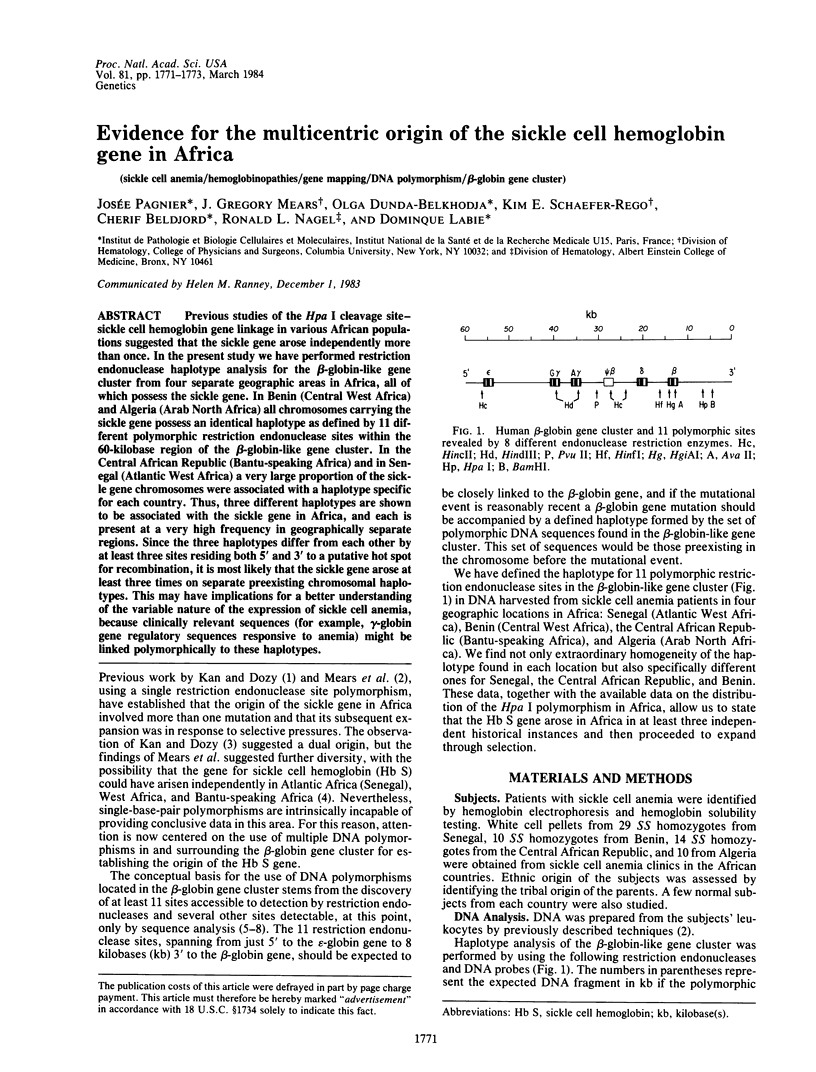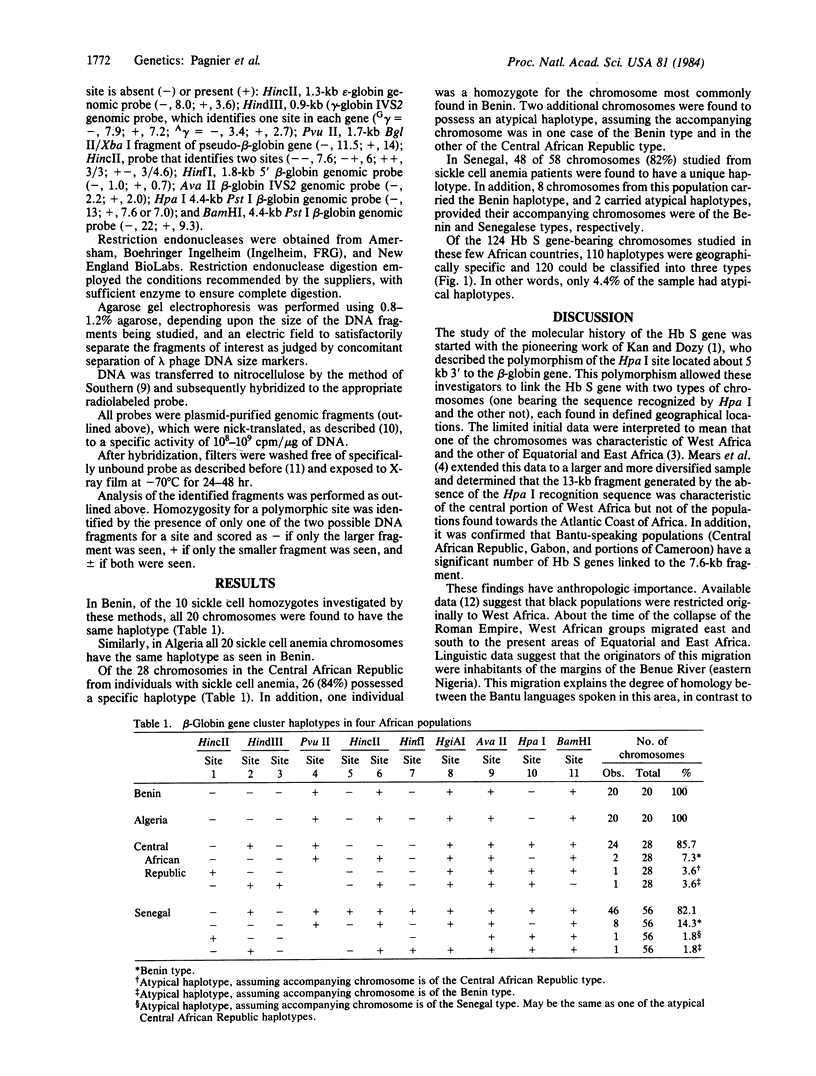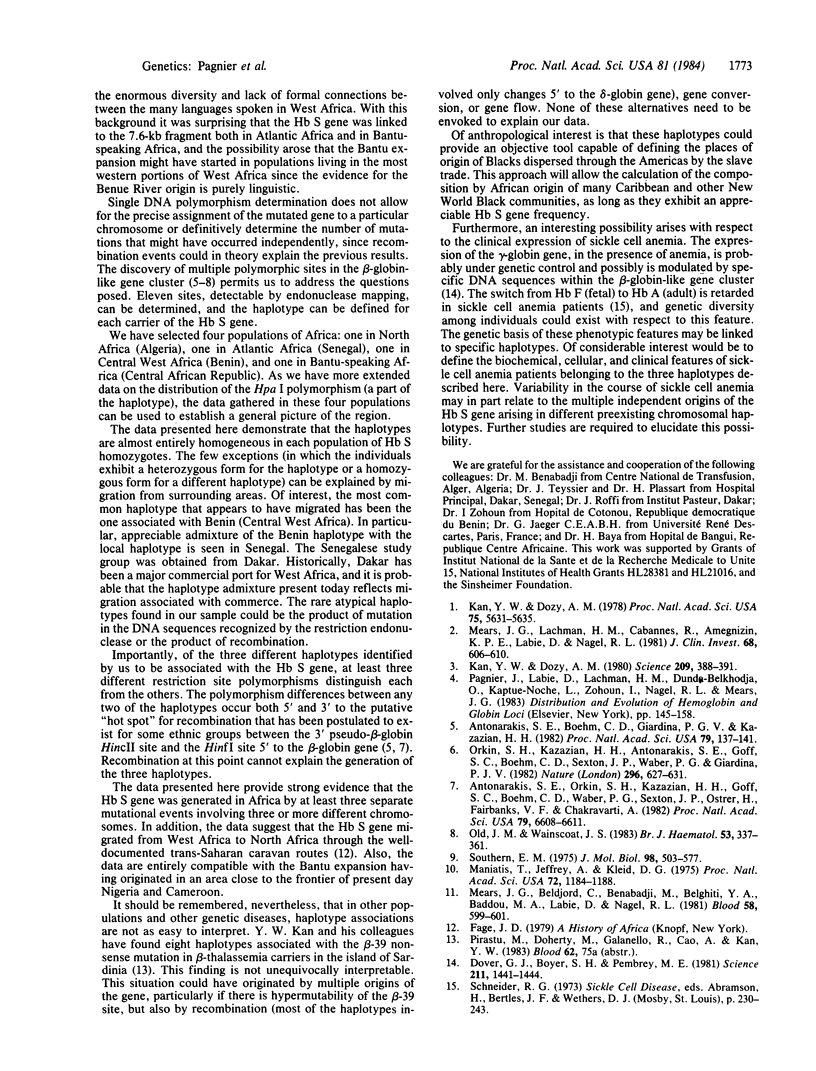Abstract
Previous studies of the Hpa I cleavage site-sickle cell hemoglobin gene linkage in various African populations suggested that the sickle gene arose independently more than once. In the present study we have performed restriction endonuclease haplotype analysis for the beta-globin-like gene cluster from four separate geographic areas in Africa, all of which possess the sickle gene. In Benin (Central West Africa) and Algeria (Arab North Africa) all chromosomes carrying the sickle gene possess an identical haplotype as defined by 11 different polymorphic restriction endonuclease sites within the 60-kilobase region of the beta-globin-like gene cluster. In the Central African Republic (Bantu-speaking Africa) and in Senegal (Atlantic West Africa) a very large proportion of the sickle gene chromosomes were associated with a haplotype specific for each country. Thus, three different haplotypes are shown to be associated with the sickle gene in Africa, and each is present at a very high frequency in geographically separate regions. Since the three haplotypes differ from each other by at least three sites residing both 5' and 3' to a putative hot spot for recombination, it is most likely that the sickle gene arose at least three times on separate preexisting chromosomal haplotypes. This may have implications for a better understanding of the variable nature of the expression of sickle cell anemia, because clinically relevant sequences (for example, gamma-globin gene regulatory sequences responsive to anemia) might be linked polymorphically to these haplotypes.
Full text
PDF


Selected References
These references are in PubMed. This may not be the complete list of references from this article.
- Antonarakis S. E., Boehm C. D., Giardina P. J., Kazazian H. H., Jr Nonrandom association of polymorphic restriction sites in the beta-globin gene cluster. Proc Natl Acad Sci U S A. 1982 Jan;79(1):137–141. doi: 10.1073/pnas.79.1.137. [DOI] [PMC free article] [PubMed] [Google Scholar]
- Antonarakis S. E., Orkin S. H., Kazazian H. H., Jr, Goff S. C., Boehm C. D., Waber P. G., Sexton J. P., Ostrer H., Fairbanks V. F., Chakravarti A. Evidence for multiple origins of the beta E-globin gene in Southeast Asia. Proc Natl Acad Sci U S A. 1982 Nov;79(21):6608–6611. doi: 10.1073/pnas.79.21.6608. [DOI] [PMC free article] [PubMed] [Google Scholar]
- Dover G. J., Boyer S. H., Pembrey M. E. F-cell production in sickle cell anemia: regulation by genes linked to beta-hemoglobin locus. Science. 1981 Mar 27;211(4489):1441–1444. doi: 10.1126/science.6162200. [DOI] [PubMed] [Google Scholar]
- Kan Y. W., Dozy A. M. Evolution of the hemoglobin S and C genes in world populations. Science. 1980 Jul 18;209(4454):388–391. doi: 10.1126/science.7384810. [DOI] [PubMed] [Google Scholar]
- Kan Y. W., Dozy A. M. Polymorphism of DNA sequence adjacent to human beta-globin structural gene: relationship to sickle mutation. Proc Natl Acad Sci U S A. 1978 Nov;75(11):5631–5635. doi: 10.1073/pnas.75.11.5631. [DOI] [PMC free article] [PubMed] [Google Scholar]
- Maniatis T., Jeffrey A., Kleid D. G. Nucleotide sequence of the rightward operator of phage lambda. Proc Natl Acad Sci U S A. 1975 Mar;72(3):1184–1188. doi: 10.1073/pnas.72.3.1184. [DOI] [PMC free article] [PubMed] [Google Scholar]
- Mears J. G., Beldjord C., Benabadji M., Belghiti Y. a., Baddou M. A., Labie D., Nagel R. L. The sickle gene polymorphism in North Africa. Blood. 1981 Sep;58(3):599–601. [PubMed] [Google Scholar]
- Mears J. G., Lachman H. M., Cabannes R., Amegnizin K. P., Labie D., Nagel R. L. Sickle gene. Its origin and diffusion from West Africa. J Clin Invest. 1981 Sep;68(3):606–610. doi: 10.1172/JCI110294. [DOI] [PMC free article] [PubMed] [Google Scholar]
- Old J. M., Wainscoat J. S. A new DNA polymorphism in the beta-globin gene cluster can be used for antenatal diagnosis of beta-thalassaemia. Br J Haematol. 1983 Feb;53(2):337–341. doi: 10.1111/j.1365-2141.1983.tb02028.x. [DOI] [PubMed] [Google Scholar]
- Orkin S. H., Kazazian H. H., Jr, Antonarakis S. E., Goff S. C., Boehm C. D., Sexton J. P., Waber P. G., Giardina P. J. Linkage of beta-thalassaemia mutations and beta-globin gene polymorphisms with DNA polymorphisms in human beta-globin gene cluster. Nature. 1982 Apr 15;296(5858):627–631. doi: 10.1038/296627a0. [DOI] [PubMed] [Google Scholar]
- Southern E. M. Detection of specific sequences among DNA fragments separated by gel electrophoresis. J Mol Biol. 1975 Nov 5;98(3):503–517. doi: 10.1016/s0022-2836(75)80083-0. [DOI] [PubMed] [Google Scholar]


